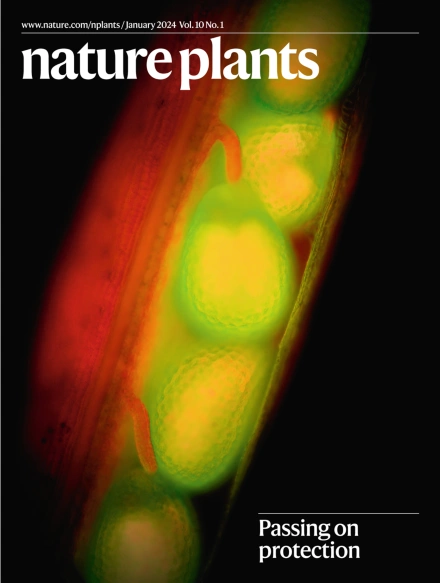拟南芥CNGC1和CNGC5的低温电镜结构揭示了门控和钙选择性的分子机制
IF 15.8
1区 生物学
Q1 PLANT SCIENCES
引用次数: 0
摘要
植物环核苷酸门控通道(CNGCs)属于环核苷酸结合域(CNBD)通道家族,但在系统发育上被划分为一个不同的分支。与动物的 K+ 选择性或非选择性阳离子通道不同,植物 CNGCs 主要介导 Ca2+ 的流入,参与各种生理过程,如气孔运动、花粉管生长和免疫反应。在此,我们对植物 CNGC 的代表--拟南芥 CNGC1 和 CNGC5 进行了冷冻电镜结构和电生理分析。我们发现 CNGC1 和 CNGC5 包含一个独特的胞外结构域,该结构域以二硫键为特征,通过电压感应结构域与孔结构域的耦合对通道门控至关重要。孔结构域选择性过滤器的收缩部位有一个决定 Ca2+ 选择性的 Gln 残基。用 CNBD 型非选择性阳离子通道中常见的 Glu 取代这个 Gln,可将 CNGC1 和 CNGC5 从 Ca2+ 选择性通道转换为可透过 Ca2+、Na+ 或 K+ 的非选择性阳离子通道。此外,我们还发现 CNGC1 和 CNGC5 的 CNBD 同源结构域含有类似配体的内在相互作用,这可能会避免环核苷酸的结合,并导致独立于 cAMP 或 cGMP 的门控。这项研究不仅从机理上理解了植物 CNGCs 的功能,还丰富了人们对 CNBD 通道的全面认识。本文章由计算机程序翻译,如有差异,请以英文原文为准。


Cryo-EM structures of Arabidopsis CNGC1 and CNGC5 reveal molecular mechanisms underlying gating and calcium selectivity
Plant cyclic nucleotide-gated channels (CNGCs) belong to the cyclic nucleotide-binding domain (CNBD) channel family, but are phylogenetically classified in a distinct branch. In contrast to their animal counterparts of K+-selective or non-selective cation channels, plant CNGCs mainly mediate Ca2+ influx and are involved in various physiological processes, such as stomatal movements, pollen-tube growth and immune responses. Here, we present the cryo-EM structure and electrophysiological analysis of plant CNGC representatives, Arabidopsis CNGC1 and CNGC5. We found that CNGC1 and CNGC5 contain a unique extracellular domain featuring disulfide bonds that is essential for channel gating via coupling of the voltage-sensing domain with the pore domain. The pore domain selectivity filter possesses a Gln residue at the constriction site that determines the Ca2+ selectivity. Replacement of this Gln with Glu, typically observed in CNBD-type non-selective cation channels, could convert CNGC1 and CNGC5 from Ca2+-selective channels to non-selective cation channels permeable to Ca2+, Na+ or K+. In addition, we found that the CNGC1 and CNGC5 CNBD homology domain contains intrinsic-ligand-like interactions, which may devoid the binding of cyclic nucleotides and lead to gating independent of cAMP or cGMP. This research not only provides a mechanistic understanding of plant CNGCs’ function, but also adds to the comprehensive knowledge of the CNBD channels. Using cryo-EM structures and electrophysiological analysis of Arabidopsis CNGC1 and CNGC5, this study characterizes plant CNGCs as a class of CNBD channels that feature Ca2+ selectivity and are not regulated by cyclic nucleotide monophosphate binding.
求助全文
通过发布文献求助,成功后即可免费获取论文全文。
去求助
来源期刊

Nature Plants
PLANT SCIENCES-
CiteScore
25.30
自引率
2.20%
发文量
196
期刊介绍:
Nature Plants is an online-only, monthly journal publishing the best research on plants — from their evolution, development, metabolism and environmental interactions to their societal significance.
 求助内容:
求助内容: 应助结果提醒方式:
应助结果提醒方式:


